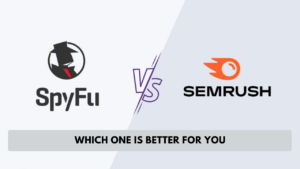Why SEO is Not Just About Keywords Anymore
Search Engine Optimization (SEO) has evolved drastically over the past decade. While keywords once ruled the SEO landscape, today’s optimization strategies are far more nuanced. Google’s ever-changing algorithms and increasing focus on user experience (UX), search intent, and authority have transformed how websites rank.
Jump to
ToggleIf you’re still stuffing your pages with keywords and expecting results, you’re likely missing out on crucial ranking factors. This article explores why SEO is not just about keywords anymore and what truly matters in the modern digital marketing world.
The Evolution of SEO: From Keywords to a Holistic Approach
In the early 2000s, SEO was primarily about finding the “right” keywords and inserting them into content as many times as possible. But as search engines advanced, keyword stuffing became ineffective-even harmful.
The Old SEO Playbook
- Keyword Stuffing – Websites packed their content with keywords, often in unnatural ways.
- Exact Match Domains (EMDs) – Domains stuffed with keywords (e.g., “BestCheapLaptops.com”) ranked easily.
- Backlink Quantity Over Quality – The more links a site had, the better, regardless of their source.
- Thin Content – Short, repetitive blog posts optimized for a single keyword.
The New SEO Reality
Search engines have become smarter, prioritizing quality over quantity and focusing on factors beyond just keywords. Today, ranking well requires a holistic approach that emphasizes user experience, intent, content value, and authority.
Let’s explore the key factors that now matter more than just inserting the right keywords.
1. Search Intent: Understanding What Users Really Want
Keywords alone don’t guarantee success anymore. What matters is understanding why users search for a particular term.
For example, if someone searches for “best laptops for students,” their intent could be:
- Informational: They want general advice on what to look for.
- Comparative: They’re weighing options between two brands.
- Transactional: They’re ready to buy.
Google now prioritizes search intent over exact keyword matches. Websites that align their content with user intent are rewarded with higher rankings.
🔹 Example: Instead of merely optimizing for “best laptops,” successful sites create detailed buying guides, comparisons, and real-world reviews tailored to different user needs.
2. Content Quality and Depth: More Than Just Words
Google’s algorithms, like RankBrain and BERT, analyze how well content satisfies user queries. High-ranking pages today typically:
- Provide in-depth, well-structured content (usually 1,500+ words).
- Include real-world examples, statistics, and expert insights.
- Use engaging multimedia (images, infographics, and videos).
- Answer related questions users might have.
🔹 Case Study: In 2021, Backlinko analyzed 11.8 million Google search results and found that long-form content ranks higher because it provides more comprehensive answers.
Simply put, better content = better rankings.
3. User Experience (UX): The Hidden SEO Factor
Google now factors in how users interact with your website. A poor user experience (slow load times, intrusive ads, or confusing navigation) can hurt your rankings.
Key UX factors include:
- Page Load Speed: Faster sites rank higher. Aim for under 2-3 seconds.
- Mobile-Friendliness: Over 60% of searches happen on mobile. Google prioritizes responsive sites.
- Core Web Vitals: Metrics like Largest Contentful Paint (LCP) and Cumulative Layout Shift (CLS) influence rankings.
🔹 Example: Amazon found that a 1-second delay in load time could cost them $1.6 billion per year in lost sales. While not every business is Amazon, slow sites drive away visitors-something Google notices.
4. E-E-A-T: Google’s Trustworthiness Criteria
E-E-A-T stands for Experience, Expertise, Authoritativeness, and Trustworthiness. Google uses these factors to determine content credibility.
How can you improve E-E-A-T?
- Showcase expertise: Author bios, certifications, and case studies help.
- Earn authoritative backlinks: Being cited by reputable sites boosts credibility.
- Secure your website: HTTPS is a ranking factor.
- Build a strong brand: Google trusts established brands more than unknown sites.
🔹 Example: A health website written by doctors will rank higher than one with anonymous, unverified content.
5. The Rise of Semantic Search and AI
With AI-driven updates like Google’s Hummingbird and BERT, search engines understand context, not just exact keywords. This is called semantic search-Google looks at the meaning behind words, rather than simple matches.
🔹 Example: If someone searches for “apple,” Google determines whether they mean the fruit or the tech company based on context.
This means content should:
✅ Use natural language instead of forced keywords.
✅ Include synonyms and related terms.
✅ Focus on topics, not just keywords.
6. Voice Search Optimization: The Future of SEO
With the rise of Alexa, Siri, and Google Assistant, more searches are now voice-based. These searches tend to be:
- Longer (full questions instead of keywords).
- Conversational (natural speech patterns).
- Local-oriented (“best pizza near me”).
🔹 Example: Instead of “best laptops,” voice users might say: “What’s the best budget laptop for college students in 2025?”
Optimizing for voice search:
- Use natural, question-based content.
- Add FAQs to target spoken queries.
- Focus on local SEO (Google My Business, reviews, and location-specific content).
7. Link Building: Quality Over Quantity
Backlinks still matter, but not all links are equal. Google penalizes spammy, low-quality links, favoring relevant, authoritative links instead.
Best practices for link building:
✅ Get mentions from high-authority sites in your niche.
✅ Create shareable content (data-driven studies, infographics).
✅ Avoid spammy directory links and link exchanges.
🔹 Example: Ahrefs found that 91% of web pages never get traffic from Google, largely due to a lack of quality backlinks.
8. Video and Visual Content: A New SEO Powerhouse
With platforms like YouTube, TikTok, and Instagram growing, video content has become a major ranking factor.
How video helps SEO:
🎬 Increases dwell time (users stay longer on pages with videos).
📹 Ranks in Google search (YouTube videos often appear at the top).
📊 Improves engagement (people prefer watching over reading).
🔹 Example: A cooking website with step-by-step recipe videos will likely outrank a text-only recipe page.
To optimize video content:
- Add keyword-rich descriptions and transcripts.
- Use engaging thumbnails and titles.
- Embed videos in blog posts for better on-page SEO.
Conclusion: SEO Is a Complete Strategy, Not Just Keywords
The SEO landscape has changed dramatically. While keywords still play a role, they are only one piece of the puzzle. Today’s SEO requires:
✅ Understanding search intent and user behavior.
✅ Creating valuable, in-depth content instead of just inserting keywords.
✅ Optimizing user experience (site speed, mobile-friendliness, Core Web Vitals).
✅ Building credibility with E-E-A-T (expertise, authority, trust).
✅ Adapting to AI-driven search trends (semantic search, voice search).
✅ Focusing on high-quality backlinks over quantity.
✅ Leveraging video and multimedia for higher engagement.
In short, SEO today is about delivering the best possible experience for users, not just gaming algorithms. Those who adapt to this shift will dominate search rankings-while those stuck in outdated tactics will fall behind.
What’s your next step? If your SEO strategy still revolves around keywords alone, it’s time to rethink your approach. Focus on creating content that genuinely helps, informs, and engages users, and Google will reward you accordingly. 🚀





